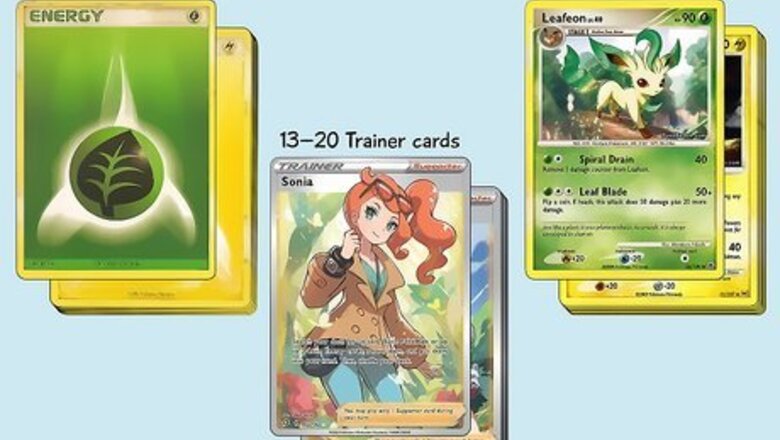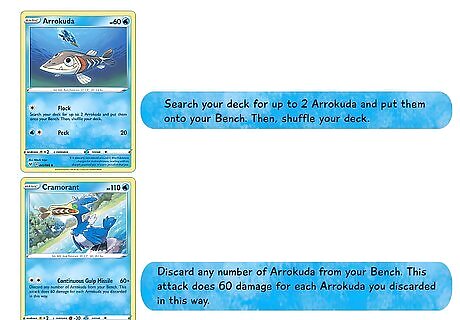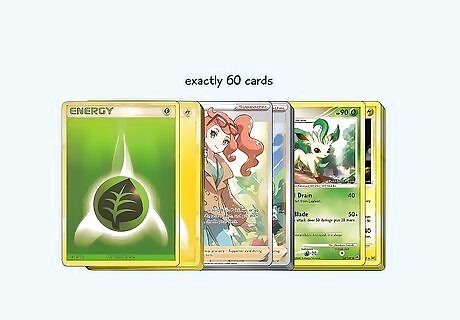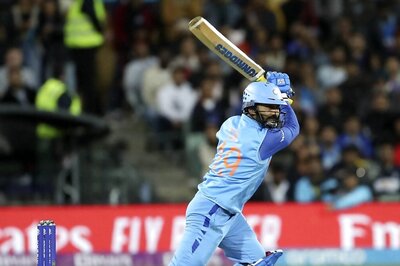
views
- Use a balanced Pokémon deck ratio that’s around 15–20 Pokémon, 15-19 Energy, and 13–20 Trainers so you have exactly 60 cards.
- Focus on 1–2 types of Pokémon so it’s easier to draw the cards you need. Pick a strong Pokémon as a main attacker to build the rest of your deck’s strategy around.
- Add Trainer cards to your deck that allow you to draw more cards and boost attacks so you can find and use your more powerful Pokémon early on in a game.
Making a Good Pokémon Deck

Use a balance of Pokémon, Trainer, and Energy cards in your deck. The main types of cards in your deck include the Pokémon you’ll use to battle, Trainer cards that grant special abilities, and Energy cards that power up your attacks. Aim to keep your Pokémon deck ratio around 15–19 Energy cards, 13–20 Trainer cards, and 15–20 Pokémon so you’re able to make a strong play each turn. Pokémon decks are exactly 60 cards, but you can adjust how many cards of each type you have to better fit your play style. Trainer cards come in 3 types: Items, Supporters, and Stadiums. Items are one-time use and any number can be played on your turn, but only 1 Supporter or Stadium can be played each turn.

Decide on 1–2 Pokémon types to focus on. There are 11 types of Pokémon in the trading card game, but including them all in your deck makes it difficult to draw specific cards you may need for your strategy. Each card type has a different play style, so choose one that matches the way you want to play as the primary focus of your deck. Then, use a few Pokémon of a different type to cover your weaknesses (for example, using Fighting-types to cover a Psychic deck’s weakness against the Darkness-type). Grass-types tend to have attacks that heal themselves or leave your opponent Poisoned. Fire-types have strong attacks that can leave opposing Pokémon Burned, but they take a lot of Energy to charge. Water-types usually have abilities that manipulate energy cards or move Pokémon around on the opposing team. Lightning-types tend to bring Energy back from the discard pile and can leave other Pokémon paralyzed. Psychic-types often have special powers that make your opponent Asleep, Confused, or Poisoned. Fighting-types have riskier attacks that do extra damage and may rely on coin flips to deal devastating combos. Darkness-type Pokémon tend to have attacks that make your opponent discard cards. Metal-type cards can resist attacks a little easier than other types of cards. Fairy-types have abilities that make opposing attacks less effective against your Pokémon. Dragon-types have strong attacks, but they usually have a higher Energy cost than other Pokémon. Colorless-type cards can have a variety of attacks and fit well as supporters in any type of deck.

Choose the main Pokémon you want to use for attacks. The hero of your deck is the main attacker that you build your entire strategy around. Use your favorite card in your collection or choose a Pokémon that has a high HP stat and powerful attacks. Include a max of 4 copies of the main Pokémon along with copies of any Pokémon in its evolutionary line so you have more opportunities to play it. Example: If you want to build a Fire-type deck around the Stage 2 Pokémon Cinderace to use its powerful Flare Striker attack, be sure to include multiple copies of its evolutionary line, the Basic card Scorbunny and Stage 1 Raboot. Basic Pokémon at the start of an evolutionary line can be knocked out quickly, so be sure you have copies of Stage 1 or 2 cards up your sleeve to quickly evolve. Pay attention to how much energy your Pokémon needs to launch attacks. Try to pick Pokémon cards that deal lots of damage or provide status ailments while maintaining a low energy cost.

Add support Pokémon that help your main attacker get on the field. Support Pokémon aren’t going to deal large attacks to your opponent, but their abilities and moves can help advance your strategy. These cards tend to let you draw more from your deck or switch active Pokémon so you can access cards that help you evolve into your main attacker and boost power. Example: A Cinccino card may be helpful because its Make Do ability lets you discard a card to draw 2 new cards and its Energy Assist attack lets you recover Energy cards from your discard pile. Avoid using too many Stage 1 or 2 Pokémon in your deck because evolving and playing them can slow down your game and leave you vulnerable to attacks. Try to pick Pokémon cards without “EX” or “GX” in their name for your support Pokémon so your opponent only receives 1 Prize card for defeating them. If you choose EX or GX cards and the other player knocks them out, they receive 2 prize cards and are closer to winning the game.

Plan your cards around your winning strategy. There are 3 ways to win the Pokémon card game: claiming all 6 of your Prize cards, knocking out all of your opponent’s Pokémon, and making your opponent run out of cards in their deck. While most decks are built around winning battles to claim Prize cards, your opponent may not suspect one of the other strategies. Choose cards that complement the strategy you want to follow so your deck is cohesive. Example: If you want to make your opponent burn through their deck faster, include Sinistea in your deck with the attack Teatime that forces each player to draw 2 cards. Example: If you want to quickly knock out opponents, use Pokémon cards that have the “Single Strike” text in the top-right corner to land powerful attacks that can defeat opponents in a single blow.

Pick cards that have abilities that synergize with others in your deck. As you’re picking cards to use in your deck, try to find play styles and abilities that complement one another to create powerful combos. As you add Trainer cards to your deck, pick a few that directly support or boost your Pokémon’s power and fit into your overall strategy. Example: Try building an offensive deck around Arrokuda and Cramorant. Arrokuda’s Flock ability lets you find more copies of the card to put into play while Cramorant’s Continuous Gulp Missile deals 60 damage for each Arrokuda you discard.

Include Trainer cards that let you draw more from your deck. Cards that let you cycle through your deck help you find the Pokémon, Trainers, and Energy cards to use for powerful turns and attacks. As you’re looking through the cards in your collection, read through the abilities on your Pokémon and Trainer cards and pick a few to include that increase your card draw so you can put your strategies into play. The Trainer card Professor’s Research allows you to discard all the cards in your hand to draw 7 new ones from the deck. The Trainer card Marnie is a great addition because it makes you and the other player each put your hand at the bottom of your deck and draw new cards. Use Quick Ball in your deck to search for a Basic Pokémon in your deck and place it directly in your hand.

Test the build of your deck by drawing a starting hand. Try shuffling your deck and drawing the top 7 cards from your hand. The first draw from your deck must contain at least 1 Basic Pokémon, or else you’ll have to reshuffle and redraw your hand. If you don’t have any Basics in your opening hand, then you may need to adjust the Pokémon in your deck or the ratio of cards you’re using to ensure you have a strong opening hand. Every time you reshuffle your deck at the start of the game, your opponent gets to draw an extra card so they’ll have more options for what to play.
Pokémon Deck Building Rules and Restrictions

Make a deck with exactly 60 cards. All Pokémon decks have to include an even 60 cards with no more and no less. As you’re building your deck, remember to include an almost-even split between Pokémon, Trainer, and Energy cards so you always have something to play on your turn.

Use up to 4 copies of cards with the same name in your deck. Besides Basic Energy cards, you may only include up to 4 copies of cards that have the same name, even if they’re from different sets or have different artwork. If the printed name of the card is different or has extra symbols, then they don’t count as duplicates. Example: Charizard and Charizard GX don’t have the same printed names, so they’re considered different cards and you’re able to have 4 copies of each in your deck. The only other exceptions to the 4-card limit are “Radiant” cards that have a special shiny coloration. You may only include 1 Radiant Pokémon in your deck.

Check the legal card sets you’re playing competitively. In competitive tournaments, older expansions are sometimes made illegal to use so the game stays fresh and challenges players to find new builds. The set of legal cards changes each year to include new expansions and card sets, so check the Pokémon TCG news site to find out what you’re currently allowed to use in a competitive deck. In the 2023 format, cards that have the “D” regulation mark in the bottom corner are no longer legal in competitive games.

















Comments
0 comment